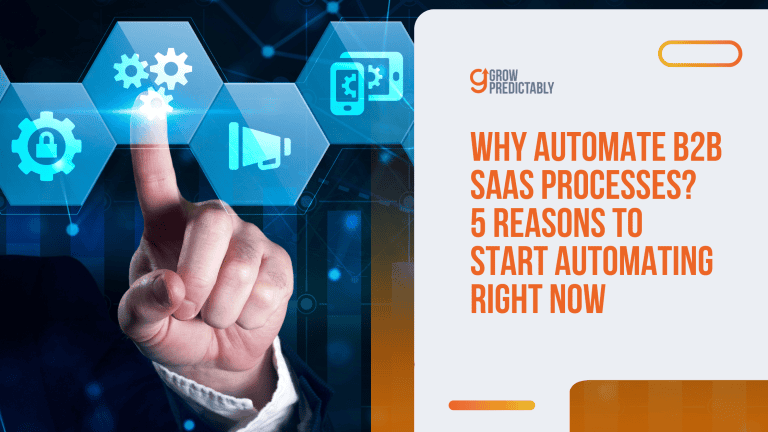7 High-Impact Tasks Coaches Can Automate for Maximum Productivity
Ever spent more time chasing invoices than coaching clients?
You’re wondering, “What business tasks can I automate to increase productivity?”
A Harvard Business Review data reveals more than 90% of professionals experienced how automation increased their productivity and helped “get more done without errors.” (Source)
Imagine scaling your income and not missing clients’ birthdays, all because the right systems are running quietly in the background.
What would your business (and your life) look like with those manual headaches gone?
Let’s see where you can start automating—without ever losing your signature personal touch.
TL;DR
Automating key business areas like client service, marketing, sales, administrative tasks, content creation, financial management, and customer relationship management can free coaches from repetitive tasks. By efficiently using tools like CRM systems and AI-based integrations, coaches can enhance productivity and focus on transformative client interactions.
KEY TAKEAWAYS
- Assess your current workflows to identify repetitive tasks ripe for automation, ensuring more time for strategic planning and client-focused activities.
- Select and implement appropriate automation tools for managing client interactions, marketing activities, and financial processes to improve efficiency and consistency.
- Regularly review and optimize automated systems to ensure they remain aligned with your business goals and continue delivering value to your clients.
What’s The Main Purpose of Automation for High-Ticket Coaches/Consultants?
If you’re in the coaching business, things can easily get overwhelming without systems regardless of if you’re new or not.
Skipped lunch/dinner for last minute rebooking? Postponed self-care sessions due to missed invoice payments from clients?
Indeed, you’re not alone in this situation.
High-ticket coaches and consultants often hit a ceiling—not because their expertise falls short, but rather because there are only so many hours you can manually nurture relationships before burning out.
Your growth gets capped by the limits of your own time and energy.
Who Is This Message For?
Let’s get specific about who you likely are.
As a high-ticket coach or consultant, you’ve built credibility in your field—whether that’s executive leadership, health transformation, or business strategy.
Consequently, you might be flying solo or leading a small support team of 1-3 people.
Your programs command $2,000+ prices because clients aren’t just paying for information—they’re paying for your personalized guidance and wisdom.
You’ve worked hard to create that premium experience that justifies your rates.
What Do Coaches Fear About Automation?
What keeps you up at night when thinking about automation?
I’ve worked with several coaches, and these fears come up consistently:
- If I automate too much, will I lose the personal touch my clients expect?
- My clients pay premium rates because of the relationship we build—won’t automation make me seem distant or corporate?
- I’ve tried tech solutions before and wasted money on platforms I barely used—what if this happens again?
Understandably, these concerns are valid.
The high-touch nature of your work makes automation feel risky rather than relieving.
What Do Coaches Need From Tech Solutions?
When we dig deeper, what most coaches/consultants really look for is:
- Revenue that can scale without your hours scaling alongside it
- Systems that feel professional and polished, reflecting the caliber of your work
- An “operating system” for your business that handles the back-end by analyzing customer behavior while you focus on transformation
- Freedom to take a vacation without your business grinding to a halt
You’re looking for tools that understand the unique rhythm of coaching relationships—not just generic business solutions.
You need automation that supports contracts, deep onboarding processes, and thoughtful follow-ups to manage routine tasks effectively.
Moreover, these systems should align with the unique rhythm of coaching relationships.
What Happens Before and After Automation?
| Before Automation | After Implementing Smart Automation |
|---|---|
| Manually sending calendar links and rescheduling when clients miss appointments | Focused on deep client transformation during your working hours |
| Creating custom welcome packets for each client from scratch | Confidently taking time off knowing systems are running in the background |
| Personally following up on every missed payment | Scaling your impact without sacrificing quality or personal touch |
| Spending evenings catching up on admin instead of recharging | Ending your workday on time, with energy left for yourself and loved ones |
Now think of a task automation software as your backstage crew—quietly creating automated workflows, setting the lights, cueing the slides, and keeping the performance flawless while you’re front and center with your clients.
The audience never sees them, but they make your starring role possible.
In the coming sections, you’ll discover how business process automation in coaching can map perfectly to every stage of your client’s journey—from the moment they discover you to the day they become your biggest advocate.
We’ll look at practical ways to maintain the human touch while letting systems handle the repetitive work.
- Your burnout comes from manual labor, not lack of passion for your work
- The right automation addresses your fears while also supporting your freedom goals
- Automation creates space for deeper connection, not detachment
Ready to see exactly how this works?
Let’s move on to mapping automation across the top seven most critical areas to your coaching service.
How Do You Automate 7 Business Areas Critical to High Ticket Coaching?
High-ticket coaches and consultants like you are constantly looking for ways to optimize your business operations to ensure sustained growth and success.
You know that time is your most valuable asset, and leveraging automation can free up hours every week, allowing you to focus on what truly matters—transforming clients’ lives.
In this guide, we’ll explore different areas of your business where strategic automation can make a significant impact by minimizing manual tasks.
Let’s dive in!

1. Client Service and Delivery
Your clients are at the heart of your business, and providing them with exceptional service is crucial to maintaining your reputation and client satisfaction.
Efficient client service not only enhances their experience but also frees up your time to focus on deep, transformative work during your sessions as opposed to spending so much time on repetitive tasks.
Without automation, you might find yourself bogged down by repetitive tasks like scheduling appointments, sending follow-up reminders, or even handling feedback collection manually.
Subsequently, these repetitive tasks can detract from your effectiveness, increasing the administrative burden and distracting you from providing high-impact coaching.
Based on one Salesmate resource, with AI, agents can resolve issues 47% faster and achieve 25% higher first-contact resolution rates than teams without automation. (Source)
By leveraging task automation tools to handle routine tasks you can focus more on delivering value and less on mundane business processes in order to improve customer service.
Examples of High-Impact Activities to Automate:
- Appointment scheduling and rescheduling.
- Sending session reminders and follow-up emails.
- Collecting client feedback or session ratings.
- Tracking client progress and milestones.
- Distributing personalized client resources post-session.
2. Marketing
As a high-ticket coach or consultant, continuously attracting your ideal clients is fundamental to growing your business sustainably.
Effective marketing strategies help ensure a steady stream of prospects who are eager and ready to engage with your services.
You might struggle with consistently creating and distributing content, managing campaigns, or analyzing data to optimize strategies.
Not automating tasks such as these can be time-consuming and overwhelming in some cases, leaving you little time for strategic planning or innovation.
Task automation tools can alleviate much of this chaos, offering consistency, accuracy, and insights at your fingertips.
Examples of High-Impact Activities to Automate:
- Email campaign distribution and engagement tracking.
- Social media post scheduling and moderation.
- Lead scoring and nurturing through CRM tools.
- Data collection and analytics for marketing metrics.
- A/B testing for marketing materials and messages.
3. Sales Process
Streamlining your sales process is key to quickly and effectively converting leads into paying clients.
An optimized sales funnel can significantly enhance conversion rates and client onboarding while minimizing the time spent per sale.
Without automation, you might encounter hurdles like losing track of potential leads, lack of follow-ups, or missing opportunities due to manual business processes.
In fact, according to Salesforce State of Sales 2024, salespeople spend 71% of their time on non-selling tasks. (Source)
These bottlenecks can stall your business growth, resulting in uncapitalized potential revenue.
Automating tasks within your sales process streamlines operations by reducing repetitive tasks, ensuring that no lead is left behind.
Examples of High-Impact Activities to Automate:
- Lead capture and follow-up sequences.
- Client onboarding workflows.
- Proposal and contract generation.
- Tracking sales metrics and conversion rates.
- Scheduling consultation calls with prospective clients.
4. Administrative Operations
Administrative tasks, though crucial, often pull your focus away from higher-value activities.
Efficient operations through automation can leave you more time to engage deeply with your clients and business strategy.
Challenges include managing appointments, invoicing, or updating client records, which are essential yet tedious repetitive tasks.
Tedious tasks like these can accumulate, leading to burnout and inefficiencies if handled manually.
Using task automation tools to automate repetitive tasks reduces overhead and ensures consistency and accuracy.
Examples of High-Impact Activities to Automate:
- Sending invoices and payment reminders.
- Updating CRM with client data automatically.
- Booking and calendar management.
- Document storage and retrieval.
- Routine email responses and client updates.
5. Content Creation
Consistent, valuable content establishes you as an authority in your field, engaging current clients and attracting potential ones.
High-quality content can drive new business and foster community among your audience.
The content creation process can feel like an endless cycle of repetitive tasks, with a need to consistently output new material across platforms.
This can be difficult to maintain alongside other responsibilities, often leading to content gaps or burnout.
Automating simple tasks within this process can ensure a steady flow of content without the constant manual effort.
It’s even more worth noting with data showing 68% of companies notice a content marketing ROI growth since using AI, this is according to statistics compiled by one Synthesia resource. (Source)
Examples of High-Impact Activities to Automate:
- Content distribution across multiple channels.
- Keyword research and performance tracking for SEO.
- Curating relevant content from external sources.
- Collecting insights and engagement metrics for content optimization based on customer behavior.
- Reposting evergreen content according to schedule.
6. Financial Management
Sound financial management is essential to understand the profitability and sustainability of your business.
Automation in this area allows you to keep your finances in check, making strategic decisions based on accurate data.
Manually managing finances can lead to errors, oversights, and stress over financial health.
Without automation, keeping tabs on income, expenses, and budgeting can be overwhelming and time-consuming.
Automating financial processes ensures you have the precise information needed for smart financial planning.
Examples of High-Impact Activities to Automate:
- Expense tracking and categorization.
- Budgeting and forecasting reports.
- Recurring billing and subscription management.
- Tax declination preparation and reminders.
- Financial performance dashboards.
7. Customer Relationship Management
Building long-term relationships with your clients enhances their lifetime value and keeps your business thriving.
A solid CRM system helps maintain those connections effectively and personally.
As your client list grows, personally managing interactions, birthdays, and special occasions can become unmanageable.
Without automation, essential touchpoints might be missed, eroding client satisfaction and loyalty.
Task automation tools such as customer relationship management (CRM) systems ensure no client falls through the cracks, maintaining strong relationships.
With AI in customer relationship management, businesses can expect to see a 10-15% increase in sales revenue and a 5-10% reduction in customer churn. (Source)
Examples of High-Impact Activities to Automate:
- Client birthday greetings and special occasion notifications.
- Personalized follow-up workflows.
- Tracking interactions and client history.
- Sending personalized content or offers.
- Loyalty and referral program management.
As a high-ticket coach or consultant, incorporating automation into these business areas can significantly enhance your productivity, allow scalability, and ensure higher client satisfaction.
By leveraging tools available to automate repetitive tasks, you focus less on day-to-day operations and more on strategic growth, creative coaching, and delivering extraordinary client experiences.
By weaving automation into the fabric of your business to take care of manual tasks, you’re setting the stage for sustainable, long-term success while enjoying a more balanced professional life.
However, for that to happen, being strategic with the tools you use is a must. It can’t just be any shiny and popular tool you see on ads and online.
Let’s take a look at your top options.
What Tools Can High-Ticket Coaches Use for Automation?
Ever downloaded a fancy app that promised the world—only to find it’s built for mega-corporations with IT departments?
It happens more often than you think.
For high-ticket coaches, picking the wrong tech stack feels like buying a designer suit three sizes too big—expensive and completely wrong for your body type.
Not all automation tools are created equal, and what works for SaaS companies or e-commerce businesses to automate repetitive tasks might leave you with wasted subscription fees.
Let’s match solutions to your actual coaching business model.
The Connection Makers

Zapier & Make.com
These platforms act like digital translators between your favorite apps, streamlining routine tasks.
Think of them as the backstage crew connecting your calendar to your CRM to create automated workflows and make sure your contract workflows run smoothly.
Perfect for: Coaches who already have tools they love but need them to talk to each other.
Furthermore, with Make.com, you can create automated workflows that trigger when a client books a call, automatically sending contracts and payment links.
Real impact: One leadership coach cut admin time by 67% by connecting Calendly, Gmail, and their payment processor through Zapier—freeing up nearly 8 hours weekly for client work.
The All-In-One Systems

Kajabi
More than just a course platform, Kajabi offers pipeline builders and seamless product delivery that feels premium—just like your coaching.
Perfect for: Coaches who sell programs alongside 1:1 work and want everything under one roof.
Worth noting: While powerful, Kajabi comes with a steeper learning curve and price tag—but pays dividends in client perception and reduced tech headaches.

Mighty Networks
Combines courses, community, and coaching in one place—ideal if your approach involves group dynamics and peer learning.
Perfect for: Coaches building communities around their expertise who want to blend 1:1 work with group programs.
Client experience boost: Your clients never need to jump between platforms, creating a cohesive, professional experience that justifies your premium pricing.
The Relationship Builders

ActiveCampaign
Goes beyond basic email with CRM capabilities, email marketing, and AI-powered lead scoring to help you focus on your warmest prospects.
Perfect for: Coaches who want to nurture relationships at scale without losing the personal touch.
Pro tip: Their automation recipes are pre-built for coaches—just tweak and launch rather than building from scratch.
The Transaction Essentials

Stripe + DocuSign
This power duo handles payments and contracts with the professionalism high-ticket clients expect.
Perfect for: Every coach needs reliable payment processing and contract signing—these are the gold standards that integrate with almost everything.
Worth knowing: HubSpot’s free CRM might look tempting, but most coaches quickly hit its limitations and need paid upgrades.
Therefore, start with task automation tools that grow with you.
The right task automation software should feel like it’s working for you, not the other way around.
One business coach put it perfectly: “I wanted tech that would make me look good in front of clients while automating tasks in the background.”
Can You Start Automation Simply?
You don’t need to start automating tasks all at once.
Begin with one painful bottleneck:
- Is scheduling eating your day? Start with Calendly + email integration.
- Drowning in contract back-and-forth? DocuSign + automatic delivery is your answer.
- Forget to follow up? ActiveCampaign sequences will remember for you.
Quick Recap:
- Start small, choose integrated tools that work together to automate repetitive tasks and establish automated workflows.
- Prioritize platforms with coaching-specific use cases and templates
- Focus on less dashboard hopping, more meaningful client interaction
Case Studies: Optimizing Workplace Wellness through AI Automation

Automation and AI are revolutionizing employee wellness, allowing companies to integrate holistic well-being programs seamlessly into their daily operations.
Let’s delve into how Wellness Coach, founded by D and Julie Sharma, leveraged these technologies to rise above wellness management challenges and enhance their operational efficiency.
Problem
Wellness Coach faced a paradox: while they were promoting workplace wellness to clients, their own internal processes were spiraling into chaos.
The team’s time was being gobbled up by mounting engineering demands, relentless client updates, and the constant churn of internal communications.
Method
To counteract this, D Sharma built a robust AI framework powered by Slack, Zapier, and ChatGPT.
This system streamlined internal operations and improved cross-departmental collaboration without the need for additional manpower.
- AI-Powered VP of Engineering: A Slack channel where junior engineers ask questions triggers ChatGPT via Zapier to provide detailed, context-rich responses, fostering a culture of knowledge-sharing while saving senior engineers 75 minutes weekly.
- Slack Reaction To-Dos: Reacting to messages with a specific emoji automates task creation in Trello, ensuring nothing slips through the cracks and saving an estimated 10.6 hours weekly across the company.
- Automated Client Follow-Ups: Post-meeting summaries pulled from Gmail or Slack create Trello action items, maintaining 100% follow-up consistency and freeing up critical time.
Results
- 10.6 hours saved weekly across engineering and operations.
- $27,500+ saved annually in productivity time, reducing additional headcount needs.
- 158 tedious tasks automated in 30 days, improving efficiency and stress reduction.
- 100% of client follow-ups remain on track with Trello integrations.
Chochi Montero: Empowering Client Success with Automation
- Meeting Summary to Trello: Automates action items creation, saving over 4.5 hours monthly.
- Check-In Calendar to Trello: Generates follow-up cards from calendar events, saving over 2 hours monthly.
- Total monthly savings of over 9 hours, making sure no client task falls through the cracks.
Takeaway
Automation isn’t just a set-and-forget tool; it’s the cornerstone for enabling sustainable growth and efficiency.
Here’s how you can harness AI in your coaching business:
- Identify Internal Bottlenecks: Start by listing repetitive tasks that AI could handle, allowing you to refocus your human resources on strategic initiatives.
- Integrate Workflow Automation Tools: Tools like Zapier can be seamlessly integrated into daily operations to automate repetitive, mundane tasks.
- Promote a Culture of Knowledge-Sharing: Use AI to disseminate internal expertise widely and consistently, reducing unnecessary dependencies on senior staff.
By embedding automation mindfully in strategic initiatives, businesses can reclaim valuable time, bolster their commitment to wellness, and maintain their focus on larger strategic goals, fostering both internal calm and client satisfaction.
FAQs
Unlock Consistent Growth and Personal Freedom
To wrap up, we’ve highlighted that the real ceiling for coaches isn’t skill or passion—it’s time and repetitive tasks.
If high ticket coaches, like yourself, automate repetitive tasks, you can finally focus on what you do best: transforming lives.
The automation software and examples here prove automation enhances, rather than detracts from, the bespoke experience your clients crave.
Picture ending your workday on time, your systems celebrating wins and handling new leads—while you recharge or spend time with loved ones.
Automation is your behind-the-scenes partner, quietly fueling your unstoppable progress as a trusted coach in your area of expertise.
It’s your turn to take the first step: Identify your main time-draining process now and try an automation software like ActiveCampaign or Calendly this week.
Let us know your results below or ask your top questions—we’re here to help you succeed.
Which business process would have the most dramatic effect if automated tomorrow? How might that shift ripple through your clients’ experience?
When you invest in automation, you’re not just buying tools—you’re designing a future-proof, client-centered business.
Are you ready to take back your time and lead your industry?








